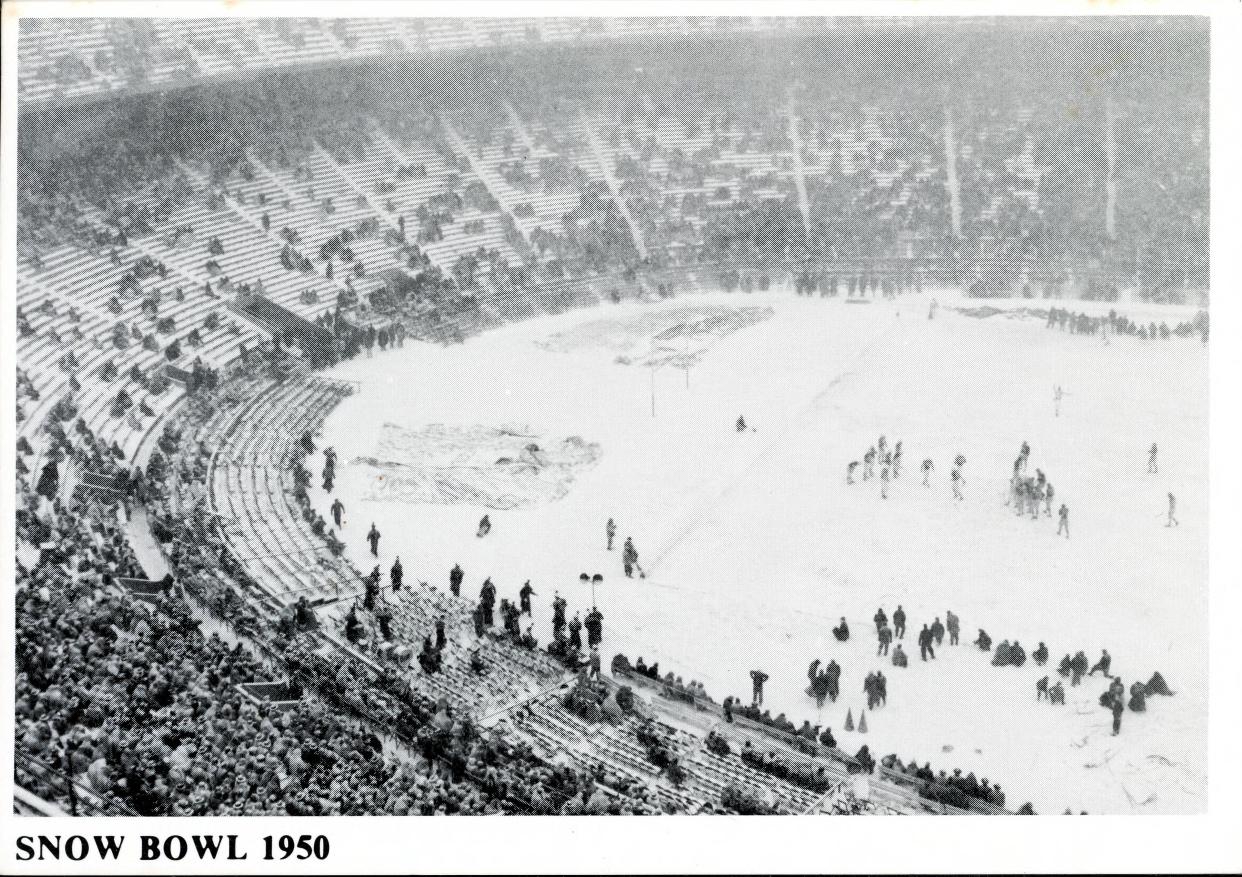Be thankful we are not facing the Great Thanksgiving Blizzard of 1950 | Theodore Decker

- Oops!Something went wrong.Please try again later.
- Oops!Something went wrong.Please try again later.
We watched the snow pile up in Buffalo, N.Y., last week in awe and disbelief.
That much snow? In November?
Madness. Hard to imagine.
But not impossible. In Ohio, there was the Great Thanksgiving Snowstorm of 1950.
It should be acknowledged upfront that lake-effect snow of the kind that pummeled western New York is a different animal than even the biggest snowstorms dished up here in central Ohio, the Blizzard of 1978 included.
Parts of western New York last week were buried under more than six feet of snow in a few days, with snow falling at the rate of three inches or more per hour.
The 1950 Thanksgiving Blizzard, as it also is known, dropped about a foot of snow across most of Ohio. The eastern half of the Buckeye State saw considerably more, though, on the order of 20 to 35 inches.
While those snow totals were far lower than the recent New York storm, the 1950 storm was no stroll through a winter wonderland.
"The legacy of a storm can be judged by how long it is remembered, and very few storms are remembered for a half a century or more," Kent State University geography professor Thomas Schmidlin told Dispatch columnist John Switzer back in 2000, on the 50th anniversary of the storm. "The Thanksgiving storm of 1950 was certainly one of them."
The snowstorm brought roaring winds to 60 mph, frigid temperatures and even a few parallels to the recent snowfall in Buffalo, from two-story-tall drifts to a high-profile debate about the feasibility of playing some football.
More:What's next for Ohio State football? An early glance at the Michigan Wolverines
More on that in a bit.

The 1950 blizzard came on the heels of an unusually warm October; Nov. 1 of that year reached 80 degrees, according to reports of the time.
By Thanksgiving, the weather had turned decidedly to winter. It was snowing by Friday, but on Saturday the storm blew up, building to an intensity that surprised even the forecasters. The barometer sank to 978mb, a reading typically reserved for hurricanes. By storm's end, 55 deaths in Ohio were blamed on the blizzard.
"The worst storm conditions occurred on Saturday (Nov. 25) ... as near-blizzard conditions prevailed throughout Ohio," Schmidlin told Switzer. "Steubenville reported 22 inches on Saturday, and drifts were reaching 25 feet in the upper Ohio Valley."
In central Ohio, those conditions meant it was time for some football.
'No need to hate':Michigan coach Jim Harbaugh approaches Ohio State game 'grateful'
Because, as any self-respecting Buckeye knows, the Saturday after Thanksgiving meant The Game, come hell or high snow drifts.
The infamous 'Snow Bowl' game between Ohio State and Michigan went on only after a heated exchange between Fritz Crisler and Dick Larkins, the athletic directors for Michigan and OSU, respectively. Crisler wanted to play; Larkins thought they should wait until Monday.
Phil Moseley, a senior manager on the Ohio State football team, recounted the scene to retired Dispatch sports columnist Bob Hunter in 2010.
"They were nose to nose, and referees and officials were there," Moseley said. "The reporter from The Dispatch and I were leaning against the wall together, trying to stay inconspicuous if we could. Larkins was on the left and Crisler was to the right, and they were close.
"Crisler wouldn't play the game on Monday. That's what Larkins wanted to do. But (Crisler) wouldn't do it, and Larkins finally gave up and frankly, even as a young kid, I was disgusted with him. I'm only 5 or 6 feet away from there and (Dispatch reporter) Paul Hornung and me, we'd look at each other and say, 'I can't believe they're doing this.'"
Moseley ran back into the locker room, where OSU Coach Wes Fesler and the players awaited their fate.
"(Fesler) said, 'Well?' And I said, 'We're...going...to...play...the...game.' And he said, 'Damn.' And that was it. We were out on the field within a half-hour."
The reported 50,000 in attendance could barely see that field. The outcome of an unforgettable game is one that OSU fans would rather forget.
Michigan won, 9-3, with a whopping 27 yards of offense. All on the ground. No first downs. Ohio State completed 3 of 18 passes for 23 yards and had 16 yards rushing. The game was Fesler's last as coach of the Buckeyes.
Rob Oller: Ohio State shows some warts. Can the blemishes be covered by Michigan game?
And here we are, 72 years later.
Today's forecast calls for sunny skies, and a balmy high of 55 degrees. It might rain a little on Saturday, when The Game kicks off at the Shoe, but there should be some sun, too, with a high of about 50.
And for that, we are thankful.
Theodore Decker is the Dispatch metro columnist.
tdecker@dispatch.com
@Theodore_Decker
This article originally appeared on The Columbus Dispatch: Thanksgiving Blizzard: Ohio snowstorm stopped everything but football
